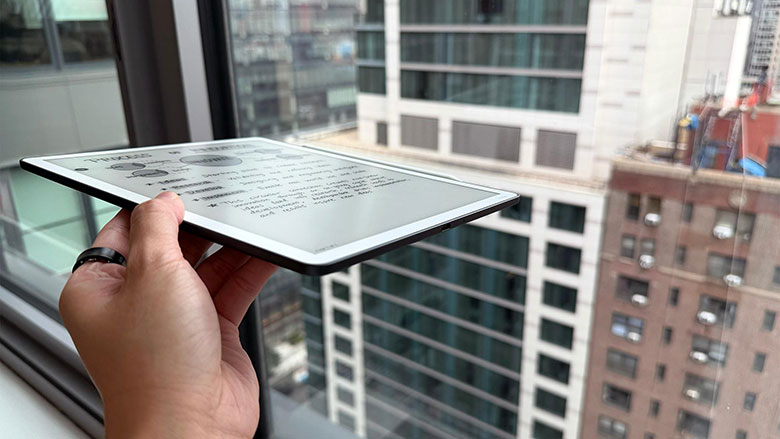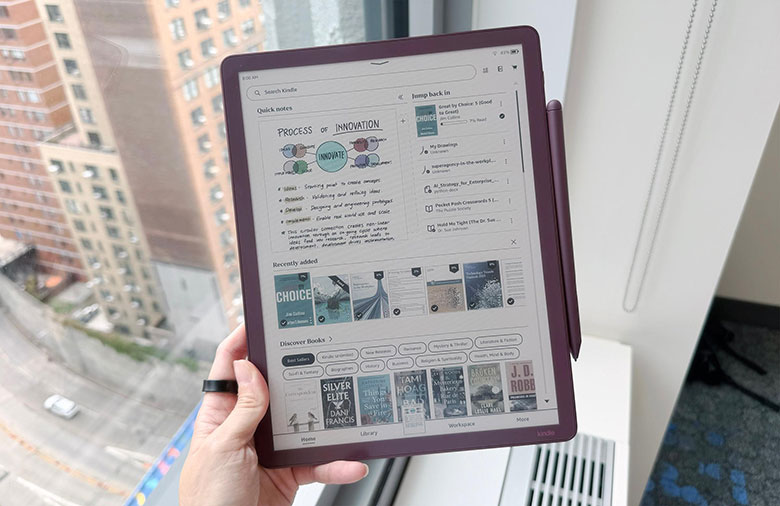Amazon has launched a new model and two upgraded configurations for the third-generation Kindle Scribe series of e-readers.
Since its launch in 2022, the Kindle Scribe has not seen significant changes in hardware, with the last update mainly involving a change in the case color. This year, Amazon introduced three Scribe models—a low-end version with a monochrome screen but no front light, a mid-range version with a monochrome screen and a front light, and the Kindle Scribe Colorsoft, Amazon’s first e-reader tablet with a color screen.
Before the Amazon launch event, I had a chance to briefly check out these three new products, and I was impressed by the responsiveness and color saturation of the demonstration units. Amazon has not yet clearly specified which generation these devices belong to, simply calling them the “new Kindle Scribe series” and appending the “Colorsoft” label to the name of the color screen model. For convenience, I will occasionally refer to these devices as Scribe 3.
I first noticed the appearance of the Scribe 3. I was accustomed to the wider bezel on the old Scribe, which was convenient for holding and wouldn’t touch the screen. This area is not just for holding; it’s also the place for placing Kindle components such as the processor and memory.
Amazon’s Kindle Vice President Kevin Keith said, “We basically stuffed all the electronic components below the screen to reduce the bezel size.” As a result, the device has a symmetrical appearance, with the four sides of its 11-inch screen (a bit larger than the previous model) having the same width. The weight of 400 grams makes it easier for users to hold it in one hand while taking notes. Keith also said that the thickness of 5.5 millimeters makes the new Kindle Scribe “thinner than the iPhone Air.” It should be noted that many tablets are very thin. The 13-inch iPad Pro and Samsung’s Galaxy Tab S11 Ultra are only 5.1 millimeters thick, while the 11-inch iPad Pro is 5.3 millimeters thick.

Amazon achieved the thinness of the new Scribe by reducing the number of layers in the screen. It removed the device’s antiglare film and switched to a non-glare screen, as well as a textured glass that simulates the friction of a pen on paper. Amazon also abandoned the touch layer that was traditionally located above the display, as it now uses a screen with integrated touch input support. Keith says that to further shrink the device, Amazon also carefully considered the size of the shell around the USB port.
On the models with front lighting, since the wide bezels are gone, Amazon had to use miniaturized LED front lights. In addition to making them smaller, Amazon doubled the number of light-emitting diodes to ensure that the light is evenly distributed across the page.
When I saw the new Kindle Scribe, I couldn’t help but pick it up and try it out, mainly because it looks very different from the old model. The thinness of the old Scribe was satisfying, and so is the new one. I am indeed curious whether I will miss the wide bezels that allow you to hold the device without touching the screen, but if Amazon’s anti-fault touch technology is effective, this may not be an issue.
I noticed that the model without the LED front light is slightly dim on the screen, but it’s still easy to read like the old Kindle. The other two models obviously look brighter and have higher contrast, making the screen text and graphics appear more vibrant and vivid. I’ll introduce the Colorsoft model later; I really like the clarity and color saturation of its screen.
This year’s upgrade has a magnetic attachment feature that I like. Specifically, the magnet that holds the pen to the Scribe has been strengthened. Keith says, “We’ve increased the magnetic force, so it’s hard to come off,” and it’s clearly more difficult to remove the pen from the device than with the previous model. Of course, it’s also easier to snap back into place. This is something I was dissatisfied with on the old Scribe, so I’m glad to see this improvement.
At Amazon’s launch event, I spent more time experiencing the new Scribe, and under the suggestion of the representative in the demonstration area, I picked up the device by holding the pen that was on Scribe Colorsoft 上. I was able to do this without dropping the device, which not only proves that the magnetic is very strong for this model but also that the device is very light.

The touch pen itself has also been improved, slightly thicker and with rounded contours, Keith says this “is more ergonomic.” It still retains the rubber head for use as an electronic eraser. When I used it on the new Scribe, just like with the old model, it always subconsciously made me want to erase the eraser shavings. The programmable operation button is also retained.
The new Kindle Scribe is equipped with a brand-new custom chip and larger memory. Amazon has also retained the oxide display from the Paperwhite reader, paired with the new processor, which Keith claims “the overall page turn speed has increased by 40%.” The responsiveness also has a significant impact on writing, with the new Kindle Scribe’s writing latency below 12 milliseconds. Place the pen tip on the screen, and the electronic ink appears immediately, the barely noticeable latency making the writing experience smoother, and the parallax effect “almost disappears” due to screen changes.
Based on my experience of drawing on the new Kindle Scribe for a few minutes, I find it hard to judge whether the smoothness or parallax effect has been greatly improved compared to previous models. The responsiveness is about the same as before, perhaps just faster during writing. Without side-by-side comparison, I can’t draw any conclusions.
I found that despite the narrower bezel of the new Scribe, it is also very easy to hold with one hand. Of course, I should note that I haven’t written on it for too long. Usually, I find it difficult to write on it unless it is placed on a flat surface, so I am curious whether the new model will make writing easier.
However, I am well aware of how the Kindle Scribe Colorsoft performs in terms of color rendering compared to its competitors. Every morning, I handwrite three pages of random thoughts, currently using the reMarkable Paper Pro. All my entries include date and time annotations, and the color rendering of that device has never been satisfactory to me. Technically, I can choose yellow, green, blue, purple, orange, and gray, but to be honest, I find it hard to distinguish between yellow and orange, and blue and gray are also very similar. Therefore, only three of the five highlight colors are truly usable (gray has almost no color at all).
The Kindle Scribe Colorsoft not only renders colors more vividly but also has more distinct hues compared to other products. I must say that the reMarkable Paper Pro feels like reading comics on faded newspaper, while the Colorsoft looks more like a beautifully illustrated novel. Although it’s still slightly dim, at least the distinct tones are visible.
Part of what makes the Colorsoft look more attractive is the device’s own beautiful purple hue, which Amazon calls “fig color.” Paired with the colors chosen on the screen, it gave me a sense of autumn, and for some reason, it also reminded me of berries. (Maybe I’m hungry.)
Like the Kindle Colorsoft released by Amazon in 2023, the Scribe Colorsoft also uses color filters and LEDs. The slight difference is that it employs a new rendering engine that can “enhance colors and ensure writing is fast, smooth, and completely natural.”
Although the Kindle Scribe Colorsoft has the same size and weight as the other two devices, its response speed is slower, at 14 milliseconds. I have only written on the Colorsoft so far, and I will spend more time experiencing both devices later to see if the different delays will have a significant impact.

In addition to the new hardware, Amazon has also upgraded the Scribe’s software. All Kindles will display a redesigned homepage that better showcases recently added and edited content. According to what I’ve seen, the homepage that showed rows of covers has been replaced with another format. At the top is a search bar, followed by a split into two columns. The left half is the “Quick Notes” section, which is essentially a notebook that can be continuously updated according to your needs, so that each time you want to jot something down, you don’t need to create a new note. The right half is the “Go Back To” area, displaying the content you’ve recently worked on.
Below this is a list called “Recently Added,” which displays the content you’ve just downloaded to the library. For example, if you’ve been reading “Body Keeps the Score” and just purchased “Katabasis,” you’ll find that the former appears in the upper right corner, while the latter is in the “Recently Added” area.
Inevitably, the top search bar now has AI support. Thankfully, Amazon is quite cautious about this, which is particularly important for products like the Kindle Scribe, where people read and create original content. This new AI feature is a more intelligent search that not only indexes all your handwritten notes but also understands and groups common themes, so you can search for content like “What did I say to Panos Panay before?” Scribe will scan your notebook, find all relevant handwritten content, present all the content you’ve written in all files, and then summarize its findings for you.
I don’t have time to try these out, but I am very interested in their potential. I’ve made many to-do lists for Engadget’s event coverage, and it would be great if I could ask “What tasks do I need to complete by the end of October” and possibly get a neat list. The use of this feature largely depends on the intelligence of the AI, so I must wait until I can do a more comprehensive review before making more comments.
Amazon also added support for Google Drive and OneDrive, so you can create folders and add documents to them on either service, and the system will download them to your Kindle Scribe. In addition to sending emails to the associated email address or finding a way to add files to your Amazon account, this is another convenient method for transferring files to the Kindle. Support for OneNote is also coming soon, allowing you to export notes as embedded images or converted text documents.
The “Send to Alexa+” feature will be launched early next year, allowing you to share notes or documents from the Kindle Scribe with the voice assistant. It will extract information from them, and remember or reference them during your conversations, so you can ask it what the next task on your to-do list is, or what items are already on your shopping list.
The redesigned homepage also has an update: Amazon will introduce a “Workspace” feature, replacing the current “Notebook” tab. Keith describes it as “essentially a new folder system.” Functionally, it’s not too different from the “Notebook” settings, but it makes it easier to group related documents for access, such as all the lists you’ve written for your wedding planning or writing project.
The redesigned homepage will be launched later this year, and all old Kindle devices will be updated to the new software. The new generation Kindle Scribe will be launched later this year, with the low-end version priced at $429.99, the version with front light priced at $499.99, and the Scribe Colorsoft starting at $629.99.
